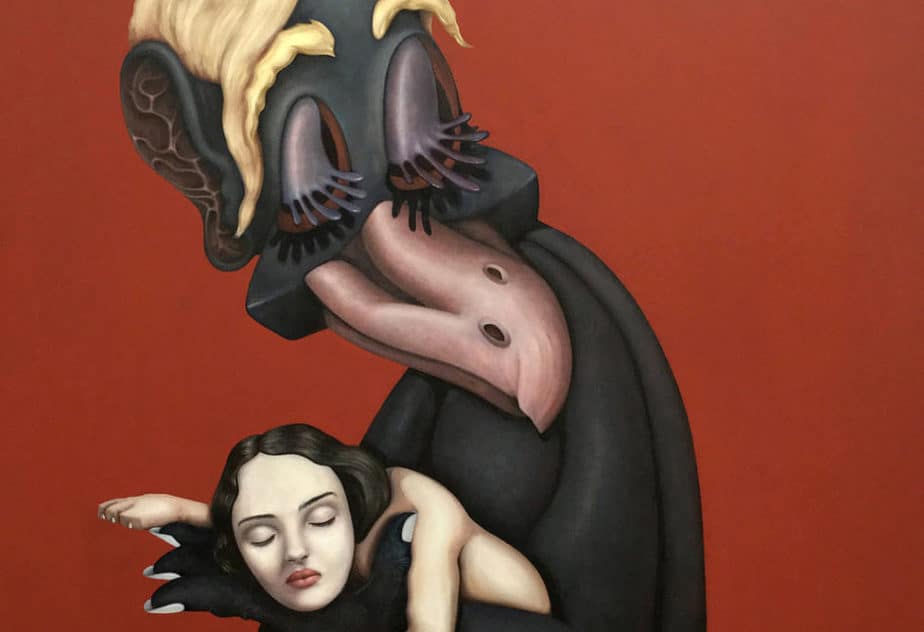Welcome back to our fall edition of Artists We Know. For our second series of articles for Quiet Lunch, we will be serving both new and lesser-known artists as well as artists well into their respective careers. So without further ado: Our second article of this season profiles Lucia Love, a visual artist whose use of evolving story arcs beckons the viewer into their own world. Read below as we dive deeper into the mind and times of Lucia Love.
Many painters aim and try to push boundaries. Of theory, a construct, or meaning and context. But few grow their voice whilst telling an intricate story such as Love does with her newest body of work.
An elevation rather than a departure from her last body of work, in Love’s newest paintings we see a burgeoning interest that leans towards a visual portrayal of written narrative and character development that she navigates through varying players in ever-expanding acts. For Love, it seems the story is never sedentary, it is always evolving along with her practice. Just as she previously worked with canvas surfaces, a recent decision to use wood has lead to effects which lend themselves to further richness and luminescence, while adding an unknown element to the oil, and as she inclines “…lays new visual dimension and further animates the figure.”

A Man Eating Ice Cream, Oil on Wood Panel. | courtesy of the artist Lucia Love
For me, Love’s work almost immediately draws into question our social conscious, mired between our outdated social structures and its failure to move past humanities truly dogmatic folklore.
While thinking further on the nature of one of Love’s reemergent characters, a female protagonist entitled “The Water Carrier” and her burden of being on a constant treacherous journey, I feel the artist has a natural creative ability to portray humanity at its most stripped and unedited nature. After all, our long dead ancestors were quite fond of the story in visual form dating all the way back to the Paleolithic era. But not all stories elevate us and strike us within a visual setting. Actually, there are literally plenty of visual artists who struggle with this and therefore depend far more on written language to supersede imagery and establish a more matured meaning to their work. Weaving these two art forms together undoubtedly requires critical thinking in both. Before even beginning to piece them together and trimming excess material that would distract the viewer from the underlying point is an art in itself.
In her studio, eight paintings are hung neatly several inches from each other. Yet somehow her work in this close proximity doesn’t over saturate the eyes. This might be due to the advanced colors that Lucia Love likes to alternate between, that often create their own mood, and which her characters inhabit from time to time.
As we attempt to get some final thoughts in and prepare the voice recorder a tiny kitten walks into the studio space where Lucia works. It’s all white and has different colored eyes, appropriately named Bowie. Uniquely striking, much like Love’s work, Bowie’s juxtaposition could fit right into one of the artist’s stories.
JO
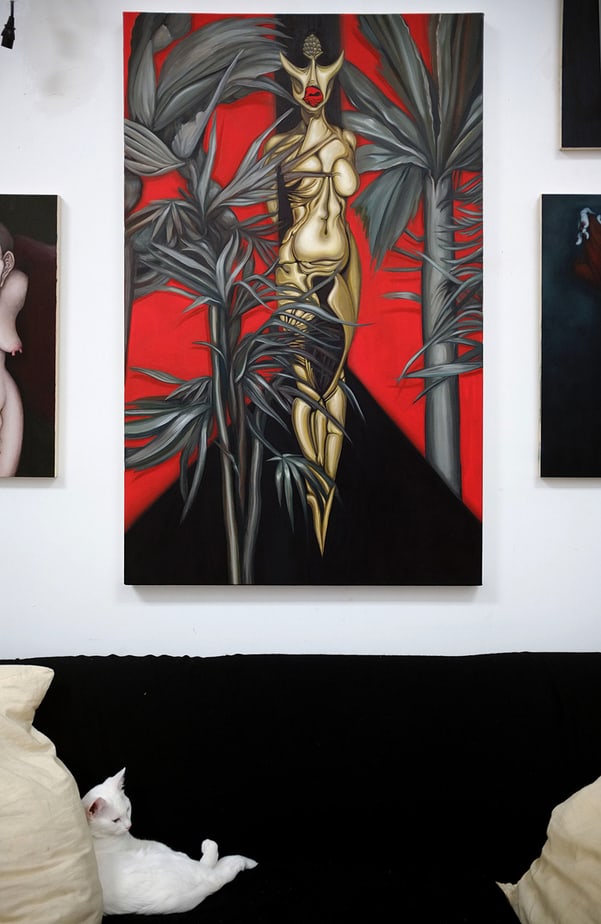
photo by Alannah Farrell. | courtesy of the artist Lucia Love
THE WATER CARRIER
J+A: Hey Lucia, we are excited to sit down and talk about some of your new work! Since your last solo show Doomerangs, that was up at Albertz Benda gallery last year, it seems like you have been working consistently on your next body of work. Can you give us the rundown on how 2017 has shaped up for you??
LL: Yes of Course! The last show of Doomerangs was an introduction to a set of characters that were populating a chaotic world. I think a lot of the chaos was created by lack of setting. This was the issue with attempting to create a dynamic portrait show. I didn’t realize, but most people walk into a room of images and expect them all to be the same somehow. Though this batch of scenes didn’t have a central protagonist at the start, it did have a breakout star. This is “The Water Carrier”. She was discovered by these innocent Spinner Boys a couple years ago. When I made that picture I was thinking of bondage and the comedy of devotion. These boys are curious about what happened to her, and getting their eyes poked for investigating. But the closet she’s in is actually a red stage! She was made to be watched.
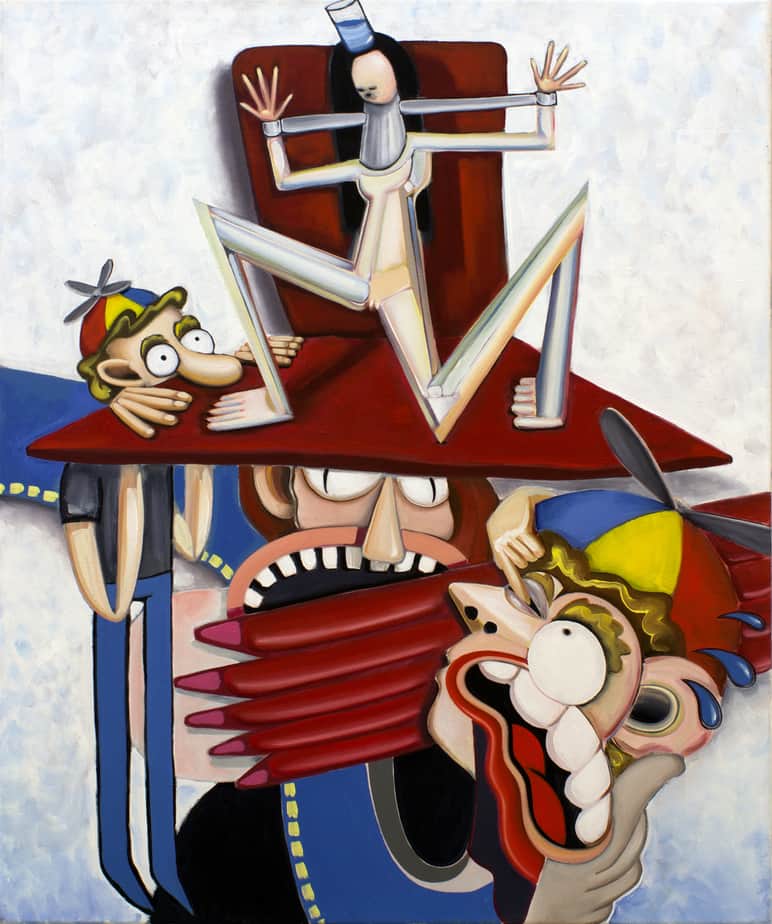
The Water Carrier, Oil on Canvas. | image courtesy of the artist Lucia Love.
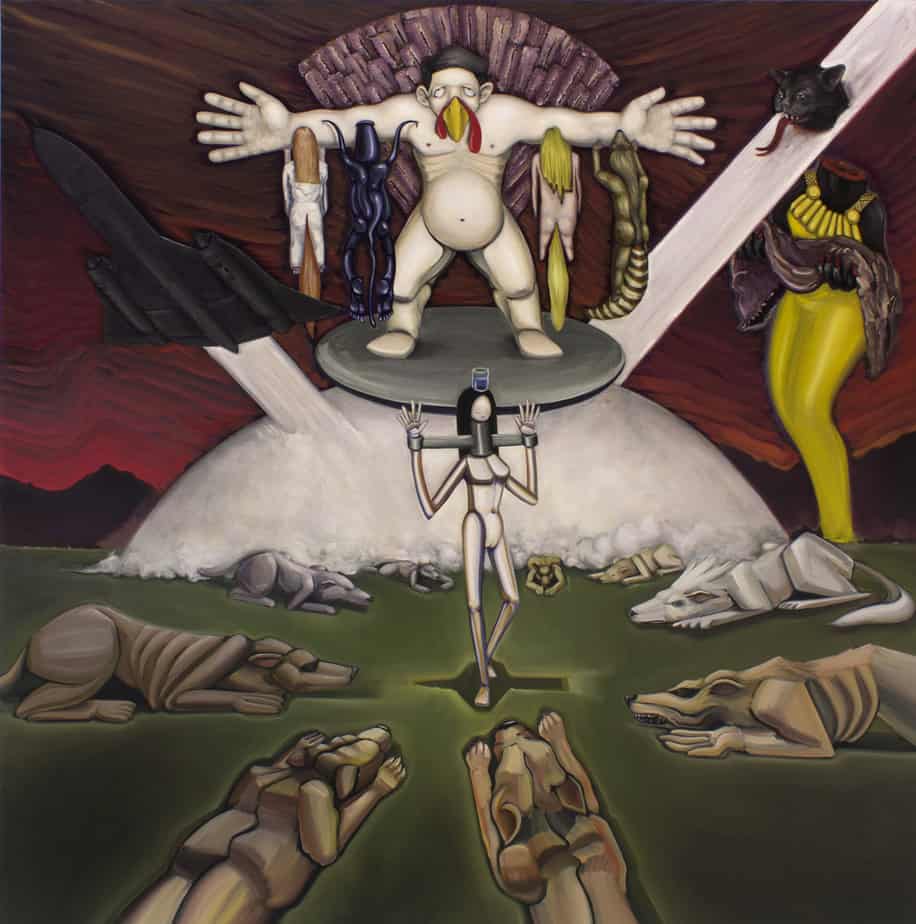
Coronation from Doomerangs, Oil on Canvas. | image courtesy of the artist Lucia Love.
J+A: Wow that’s quite an interesting way of working! So backtracking a bit how did the character development for this expanding story-line originally begin? Did it come to you naturally? Or is creating a world of your own a process that requires time, revisions, etc?
LL: I think of myself in A Beautiful Mind at a wall of connections, just talking to myself going, “Yeah. Oh yeah. That’s correct. Then there’s a dog with no eyes, feeling around in a plush carpet with white gloves on in the dark, on gilded kneepads, slowly becoming indecipherable as her body devolves into pattern. Poor rich dog.” Once something like this comes up I can feel the narrative value of her existence. But there’s no one to tell that story to. It needs a picture for people to grasp. Then it’s time to draw a body for the idea. Each piece ends up as a poem about moments where depravity meets amusement. There doesn’t have to be a lot of group interaction in a cast for me to be amused. I think of this world more as a cross-section of apartment buildings. It’s possible for them to meet their neighbors, but they just may Netflix and chill instead.
J+A: How did the water carrier’s story arc take off initially? Was it a clear choice?
LL: Well her story arc has always evolved in sections really. First, she is discovered, you see her with the man who drinks from her cup, an angel comes to refill the cup, and then she learns to stand up. When this happens, shit gets crazy. She attracts a Turkey God, who is a strong protective symbol of potential. He is always pregnant, and many small, beastly women come to leech off of him. She also achieves the respect of a pack of wolves who appreciate The Water Carrier’s denial of a false god – the large black cat odalisque who is trying to make The Water Carrier wear an unflattering dress. In later paintings we come to understand The Water Carrier has become telepathic like Tetsuo from Akira, and so was able to guide a stealth plane through the odalisque’s neck. She is now evolving into the fulcrum of a more complex fiction. I think this is also going to mean she will encounter more complex renderings on her present trek through the desert.
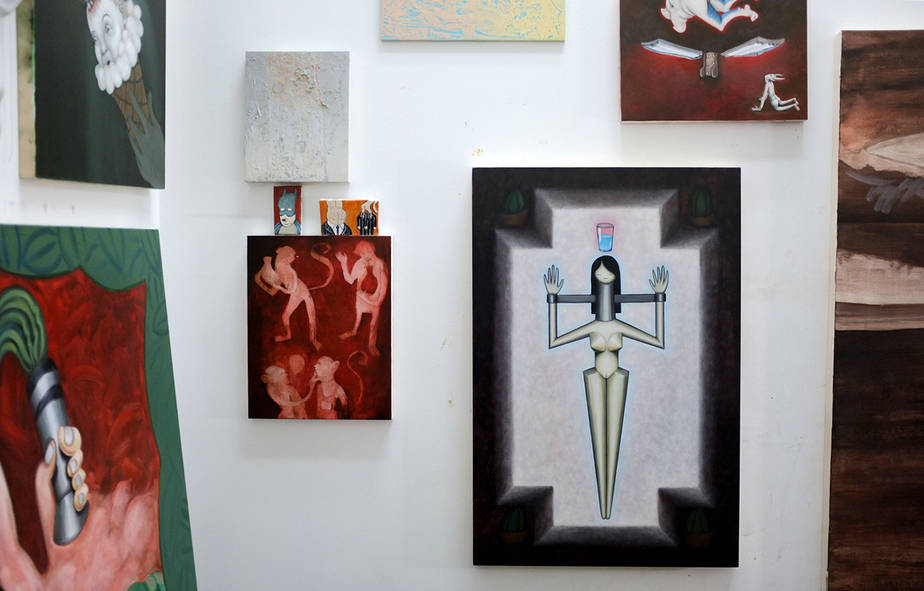
photo by Alannah Farrell. | courtesy of the artist Lucia Love.
J+A: The narrative story-telling aspect within your visual work seems so ingrained and natural that it would be sort of odd to imagine it without. Do you ever see an end or finite narrative that is pre-disposed to end at a certain point?
LL: Not really. Is Mickey Mouse dead? For my characters, I tend not to think of them in time. Cartoons don’t age. Currently, my characters are going on a journey, and I do know that the destination is a place called Fair Haven. One scene from inside Fair Haven has been captured so far. But in 10 years? I dunno, maybe I’ll just be making landscapes, and all of the old stars will be bones underground.
J+A: Your style of painting uses something we might describe as varying figurative voices. Some of your characters seem to have more realism intertwined while others are more loose and emotive. We see many artists get lumped into categories mainly just because of a style or aesthetic, this can be a flattering or a highly restrictive take on their work. What’s your take on your artistic practice and the stylistic choices you make?
LL: “Varying figurative voices” – I love that! Yes definitely. Style is for the art fairs. Honestly, my main concern moving forward is legibility and impact. There’s a lot to think about with this one shackled character who’s basic features will always remain. What does it mean to carry water? People are doing that around the world with various containers. Plastic bottles, cups, jugs, towers, trucks, tons of tons of toilets, sinks, and swimming pools being filled and drained through sewage pipes and treatment facilities. Riots are born from drought and the growing cost of this basic resource. And yet, to “carry water” for someone also means you’re devoted to them. It is also a measurement of outlook to have a half cup of water. How can I make a form with enough flexibility to address this element with ever more wokeness so I don’t lose respect for myself in the valley of the vultures?
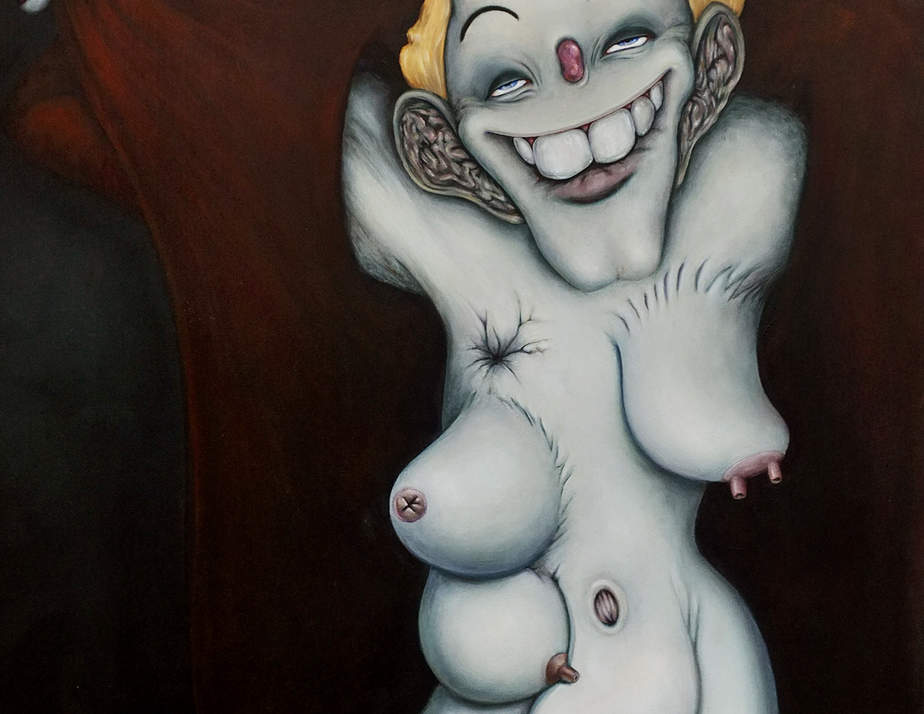
Detail of Dolphin Boy, Oil on Wood Panel. | Courtesy of the artist Lucia Love.
J+A: True, it sounds like quite a challenge to deal with something so integral to life on this planet as water! But it is really fascinating to learn how you’re thinking about the Water Carrier’s role (or possibly origin and duty) in such a multi-faceted way. Looking at your work we get the feeling that the viewer could approach it with many different ways of thinking. Even considering the narrative element to your work, we feel a certain freedom to our minds drifting in different directions with it. Perhaps it inspires the viewer to think in a more multi-faceted way also.
On another note, when humans listen to music or go to the cinema there is always an emotional connection. Are you ever inspired by these other mediums?
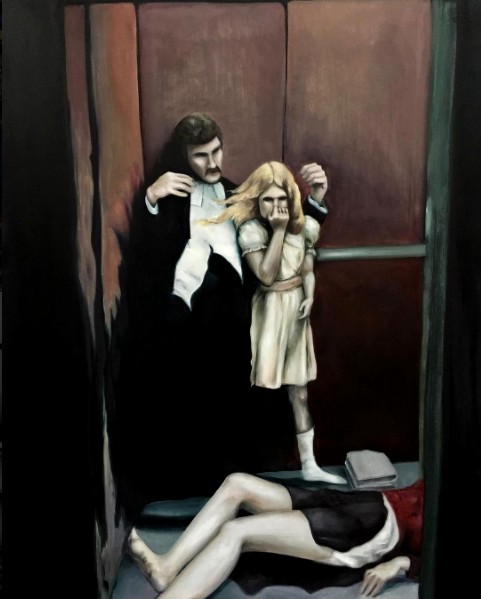
Cronenberg’s Elevator, Oil on Wood Panel image. | courtesy of the artist Lucia Love.
LL: Inspired by other mediums. For sure! I love watching cartoons and horror movies. And of course, horror is comedy. Sometimes to take a break from my own stories I like to make little paintings or drawings from scenes that I constantly return to. Like this one still from Shivers by Cronenberg. There’s a scene towards the end of the film when most everyone has been infected by a weird parasite that makes them into sexual zombie monsters. In this scene around an elevator, a cop is trying to get on, but the car is occupied by an adult man caressing a girl child while an adult woman lay at their feet, presumably dead. I didn’t know why I liked this image until I painted it, and realized this configuration was about the horror of a replacement for me. Like this is a dark world with no moral structure so no one has to deal with consent. Predators could act on impulse, and desirability is the only currency. That sadistic amoral blindness is horror. Lol. A lot to think about for around 10 seconds of screen time.
J+A: We’re down with the Cronenberg too!
With that said it’s been a pleasure getting to know a bit more about your new work, your kitten, and we might just have to re-watch Shivers tonight for a post-Halloween treat! Thanks, Lucia!
Every two weeks for the next several months we will be publishing new and engaging articles emphasizing the importance of independence within our creative community. Stay tuned for more compelling stories by @jaredxalannah for ‘Artists We Know’ series: II & Quiet Lunch Magazine.
Follow Lucia: @lucia_love
You can check out Lucia’s brilliant work, her bio & up-coming exhibitions here: http://www.albertzbenda.com/artists/lucia-love/

Artist duo Jared Oppenheim and Alannah Farrell work in mediums that include painting, multi-media and installation works.
Their work has appeared in publications including Quiet Lunch, Juxtapoz, NY Magazine’s Bedford + Bowery, New York Optimist, Next, and The Wild Magazine, amongst others.
Together and separately their work has been presented and curated in London, Berlin, and in NYC. Currently, they live and work in the East Village, NYC.
For more of Jared x Alannah’s AWK Series, click here.

